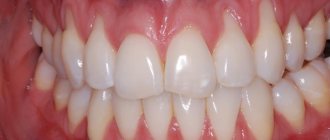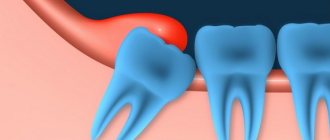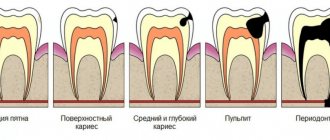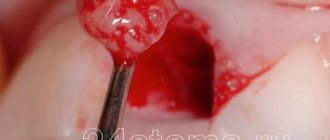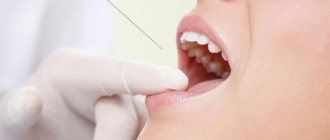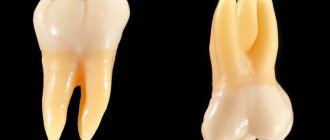Dental implantation is used when a tooth is lost or removed. We are talking about installing an implant, on top of which a crown is placed. the procedure has a number of contraindications. For example, it is not recommended for patients under 18 years of age, as this may affect the development of the dental system. In this case, there is a good alternative - transplantation. In many cases, this is the only opportunity to restore the integrity of the dentition, chewing functions, and aesthetics.
What complications can there be?
After autotransplantation, the risk of tooth rejection remains.
According to statistics, this happens in 5-20% of cases, but in fact it greatly depends on the skill of the doctor and the efforts of the patient. There is also a possibility of root resorption of the transplanted teeth and their replacement with bone tissue within 2-4 years. That is, the tooth fuses directly with the bone, without the periodontal ligament. This means that it does not cushion when chewing, and this can create certain problems. But such situations again depend on how carefully the dental surgeon preserved and transferred the roots of the tooth to a new place.
That is, the difficulties in general are associated with a lack of practice - many doctors prefer to immediately offer implantation rather than consider an alternative.
However, even if the tooth does not take root in the new place, this is not a death sentence. Of course, you lose time and money spent on treatment. But even in case of failure, there are still options to install an implant or a bridge. And if the transplantation is successful, you will save significantly.
Dental transplantation
Tooth transplantation involves transplanting an existing tooth germ or a whole tooth to the desired location. With autotransplantation, the dentition is replaced using the patient's own teeth. The tooth or its rudiment is embedded in the root in such a way that it can develop in exactly the same way as its neighbors. This is the main advantage of the procedure.
The considered technique is used when:
- loss of a healthy tooth due to injury;
- absence of a tooth and a formed rudiment from birth;
- removal of the affected tooth;
- removal as indicated by a doctor (for example, to avoid malocclusion).
To eliminate infectious pathologies, the reimplantation technique is used if the pathology cannot be treated conservatively. It consists in the engraftment of the tooth after preliminary removal. Both procedures are aimed at preserving the integrity of the tooth and root.
What are the alternatives?
The most inexpensive way to replace a missing tooth is to install a removable butterfly denture. But it is quite noticeable from the outside, does not restore chewing function well and does not hold securely, so it should only be considered as a temporary solution to the problem.
Another common method is a bridge, which before the advent of implants was the most popular way to replace a lost tooth. The design consists of connected crowns - the outer ones rest on living teeth, and the central one fits tightly to the gum and closes the void. But to install this prosthesis, you will have to sacrifice two healthy adjacent teeth by grinding them down. And bone atrophy progresses under the prosthesis.
The most optimal alternative is dental implantation. This is the restoration of the crown of a tooth on an implant, which is fixedly installed inside the jawbone, exactly where the root of the living tooth was. However, this treatment will take longer compared to autotransplantation, especially if bone needs to be built up first.
1 Tsukiboshi M, Yamauchi N, Tsukiboshi Y. Long-term outcomes of autotransplantation of teeth: A case series. Dental Traumatology, 2019
Stages of transplantation
The procedure is carried out in several stages:
- Diagnosis based on X-rays and computed tomography.
- Removal of a damaged tooth.
- Treatment of the transplant site with a special antiseptic composition.
- Extraction of a germ or tooth for transplantation.
- Implantation into a prepared place.
- Placing a splint for fixation.
- Stitching.
The splints are removed after approximately 20-30 days. This is the optimal period for tooth adaptation. Using this technology, you can completely restore a healthy tooth and prevent malocclusion.
How does the autotransplantation process work?
- In order for the transplant to be successful, you need to make sure that the donor tooth is the right size for the socket of the tooth that needs to be removed. The doctor evaluates the shape and size of the donor tooth on a CT image.
- We scan the tooth and print a three-dimensional model of the tooth on a 3D printer. It is made of special plastic.
- The doctor tries on the future donor tooth (this happens even before extraction).
- Next, the dental surgeon atraumatically removes the decayed tooth. Places a 3D model of the future donor tooth into the socket and carries out the final fitting.
- The doctor then very carefully removes the donor tooth and moves it into the socket of the newly removed tooth. Places stitches and strengthens with a splint. The surgical part is completed. Next - inspections.
- You have had a tooth transplant. What is important to know? Recommendations from our doctors!
Rehabilitation period
After replantation, the patient must adhere to strict recommendations that will completely restore the dentition. One of them is following a diet. Any solid foods should be excluded from the diet. It is better to puree food in a blender.
It is also very important to properly perform oral hygiene using special rinsing solutions. In some cases, the patient may be prescribed UHF therapy sessions, which can speed up tissue restoration.
Throughout the entire rehabilitation period, the patient is required to regularly visit his doctor to monitor the healing process.
Anesthesia.
To remove even the most difficult wisdom teeth, local anesthesia is sufficient.
Firstly, it is as safe as you can imagine and is suitable for absolutely everyone. Properly administered local anesthesia is at least several hours of persistent pain relief, sufficient to not only remove wisdom teeth, but also perform rhinoplasty and mammoplasty as a gift.
Secondly, local anesthesia has one significant advantage. In our opinion, the most important thing is maintaining verbal and non-verbal contact with the patient. Local anesthesia and preservation of all cognitive functions, at a minimum, eliminate treating the patient like a piece of meat - we feel you, worry with you and strive to cause as little discomfort as possible. A number of researchers have studied the morbidity and incidence of complications, comparing operations under local and general anesthesia, and the results of the studies were far from in favor of the latter. And there is an explanation for this. The lack of reactions on the part of the patient under sedation “frees the hands” of the surgeon; direct and feedback connections are lost between him and the patient - because of this, the traumatic nature of the operation increases sharply.
For local anesthesia when removing wisdom teeth, we use anesthetics familiar to all dentists. Mainly based on Articaine - as the most effective and safe.
Why do you need to place an artificial bone in the figure eight hole?
The purpose of this procedure is one thing - to shake out more money from you, otherwise the doctor has a car loan and a mortgage. Even the most expensive biomaterials placed in the sockets of wisdom teeth do not play any useful role; their use does not carry any meaningful meaning. But it can be worse - they often fester and complicate the course of the postoperative period, leading to very sad consequences. In other words, you cannot use “artificial bone” when removing a wisdom tooth. Even if you really want to.
The most we use are collagen sponges soaked in anti-inflammatory compounds. They help stop socket bleeding and minimize inflammatory symptoms (primarily pain) immediately after removal. And they stand... they cost almost nothing.
Advantages and disadvantages
The main advantage of this method is the ability to save a tooth that has been damaged. At the same time, the dentition retains its natural appearance, and the person does not feel any discomfort after complete engraftment.
Also among the advantages are:
- the ability to perform replantation in one step over a short amount of time;
- high probability of engraftment, even if it was outside the oral cavity for up to 48 hours;
- maintaining the functionality of the implanted tooth for up to twenty years.
Another advantage is the short recovery period, which often passes without much discomfort or pain symptoms.
The main disadvantage of replantation is the likelihood that the tooth will not heal. This result is possible if the tooth was stored in incorrect conditions before the operation, or the doctor made certain professional mistakes.
Other disadvantages of the procedure include:
- the presence of a large number of contraindications that may interfere with the operation;
- If there is significant damage to the crown, replantation may not be possible.
Patients often consider the disadvantage of having to adhere to a very strict diet and oral care recommendations during the rehabilitation period.
"Eights" and complications associated with them
When wisdom teeth erupt, they can form what is called a “hood.” This occurs when the gum above the tooth is partially preserved. The danger is that food debris can get into this kind of gum pocket, decompose there and cause inflammation. The development of such a process will require treatment. First, the dentist must rinse the pocket with a special antiseptic, apply medicine, and prescribe some medications depending on the degree of the inflammatory process. When the inflammatory process is resolved, the doctor will recommend removing the wisdom tooth. During the acute inflammatory phase, teeth are usually not removed.
“Eights” can erupt towards the tongue or cheek, causing chronic injury to the mucous membrane, which can lead to tumors, ulcers and cause a lot of discomfort.
Let’s say the eighth tooth erupted normally, but a cavity has formed between it and the seventh tooth, where food regularly gets clogged. This can lead to a fairly rapid development of the carious process, which affects not only the wisdom tooth, which is absolutely useless for a person, but also the strategically important seventh tooth. As a rule, in case of interdental caries on such teeth, the “eight” must be immediately removed, and after the socket is restored, a filling is installed on the seventh tooth.
Another complication occurs when the hidden eighth tooth, located horizontally in the gum, rests on the root of the seventh tooth and begins to injure it, leading to the formation of a cyst. In worst case scenarios, such inflammatory processes can even lead to jaw resection. Unfortunately, these cysts can develop asymptomatically for quite a long time. That is why you need to undergo dental examinations every six months and have dental x-rays done every 2-3 years.
Preparation for replantation
Before the operation, the doctor examines the patient’s oral cavity and selects the appropriate technique.
Mandatory training includes such manipulations as:
- treatment of identified dental diseases;
- cleansing tooth enamel from stones and pathogenic plaque;
- cutting off the upper part of the root;
- cleaning and filling carious cavities (if any).
After preparation and elimination of defects, the patient is sent for an x-ray. Using X-rays, the doctor assesses the quality of the filling and then begins replantation.
Important! Immediately before the procedure, you should not eat, smoke, drink alcohol or exercise, and your mouth should be clean.
Types of procedure
Surgery to replant a damaged tooth can be performed in two different ways:
- vital;
- devital.
During vital replantation, the tooth is healed while preserving the nerve. At the same time, its canals are not cleaned or sealed. This allows you to preserve the natural integrity of the tooth, thanks to which its functionality and aesthetic characteristics are preserved for more than ten years.
The devital method involves the initial removal of the nerve, cleaning and filling of its canals. This manipulation can be performed on any tooth, regardless of its location in the oral cavity.
During each type of intervention, the hole in which the tooth was placed must be cleaned of affected tissue and disinfected. As for the roots, they are cut off at the top.
Is it possible to transplant a healthy tooth?
Dental transplantation is the transplantation of your own tooth in place of a missing one.
The main indications for dental transplantation are:
- Tooth loss due to injury.
- Tooth loss due to complications of caries.
- A congenital defect in which the embryo never forms.
Most often, transplantation is performed on the site of missing sixth teeth, since they usually appear earlier and are more susceptible to caries and destruction than other teeth. In their place, wisdom teeth are transplanted.
Today, the installation of implants is quite common, and you, of course, ask whether it is worth doing a dental transplant when there is an alternative. And what to choose: implant installation or tooth transplantation.
Let's find out!
In order to carry out a transplant, it is first necessary to study a CT scan and determine whether the tooth is suitable for transplantation or not. There are patients for whom, unfortunately, it is impossible to undergo a transplant.
Also, we must not forget that while adults can restore a missing tooth with an implant, this is contraindicated for children and adolescents. This is because the process of jaw growth occurs before the age of 21 and after installation of the implant it can move. Therefore, the main indication is the absence of a tooth at an age when the jaw system is not yet fully formed.
Tooth transplantation and implantation have a similar survival rate of 98%.
What's faster?! In terms of timing, tooth transplantation wins - 1-1.5 months, and implantation - 3-4 months.
Implantation often requires gum and bone plastic surgery, as opposed to transplantation.
Installing a crown on an implant is mandatory, but during transplantation it is not always necessary.
Stages of tooth transplantation.
- Examination, medical history, assessment of the destruction of the tooth being removed, as well as the condition of the gums and adjacent teeth and graft.
- CBCT analysis: determining whether a given tooth is suitable for transplantation or not, assessing the location of the roots, whether there are any acute inflammatory processes.
- Measurements are taken of the removed and transplanted teeth and a check is made to see if the tooth is suitable for the place of the transplanted one.
- Making a tooth template to try on the location of a new tooth in place of the old one.
- Direct transplantation and fixation of the new tooth with a special splint in order to stabilize and fix the tooth in the new socket.
- Treatment of canals in the transplanted tooth, since during removal the neurovascular bundle of the tooth is torn off.
- 4 weeks after surgery, the splint is removed and examined.
Transplantation is sometimes confused with tooth reimplantation, however, these procedures have a fundamental difference. During reimplantation, the tooth is removed and then implanted in its original place - in the same socket. The purpose of this procedure is to eliminate the source of infection, which cannot be treated with conservative methods.
Wisdom teeth: an unnecessary vestige or support for a prosthesis
Wisdom teeth are also called “eights.” Almost every person faces problems that are caused by these rudiments. Previously, dentists were unanimous - figure eights should be removed.
There are many problems with eights, which justifies their removal in the vast majority of cases. Let us outline the main difficulties:
- Late cutting. Eight does not have a milk predecessor, its birth is more difficult and painful.
- Wisdom teeth often grow with deformities. A common pathology is dystopia. In this case, the rudiment can only partially erupt. Supporting the adjacent unit in a row and growing “sideways” lead to damage to neighboring teeth.
- The inaccessibility of this element in the row makes it difficult to clean, which contributes to the formation of a focus of bacteria. These are optimal conditions for the development of caries and inflammation.
